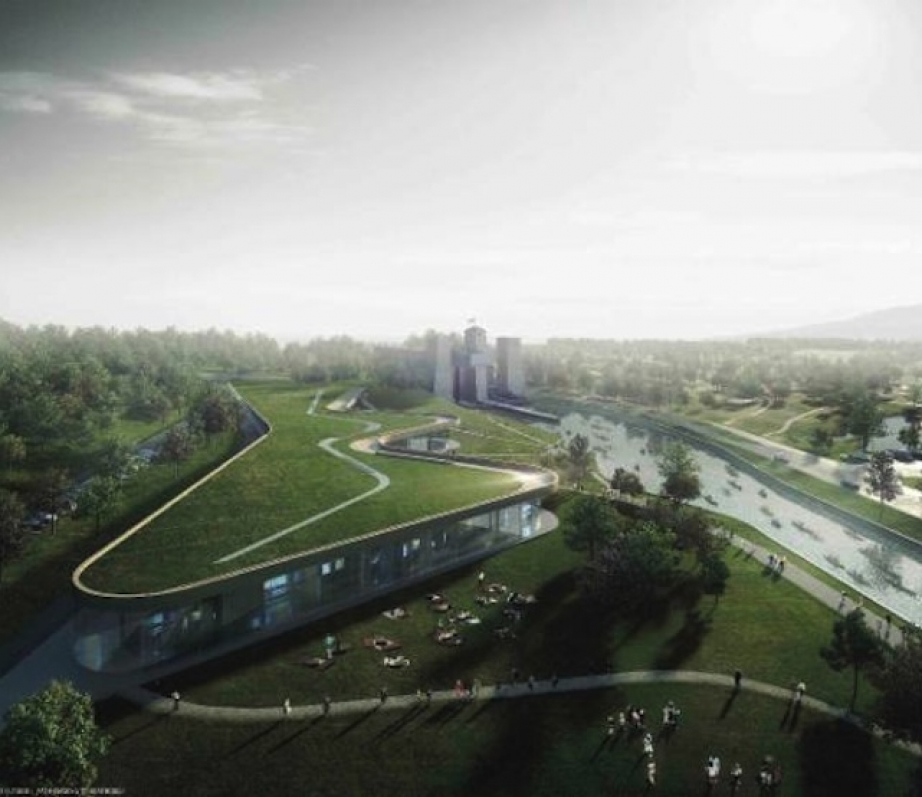— The following is a press release from the Canadian Canoe Museum —
Members of the Architect Selection Committee and the Board of Directors of the Canadian Canoe Museum are proud, honoured and excited to announce that visionary architects heneghan peng Architects (Dublin, Ireland) and Kearns Mancini Architects (Toronto, Ontario) have won the international competition for the new $45-million Canadian Canoe Museum to be located at the majestic site of the 1904 Peterborough Lift Lock National Historic Site.
An elegant, serpentine glass pavilion graced by a two-acre rooftop garden has been selected as the winning design in the two-stage international competition. The design to house the world’s largest collection of canoes and kayaks presents a Canadian game changer that organically and boldly curves out from the drumlins beside the Trent-Severn waterway. Envisioned with and for the community, the museum embraces aboriginal wisdom to live and build lightly on the land.
The Irish-Canadian design team brings to the Canadian Canoe Museum its rich experience in the design of high-profile museums and visitor centers in Toronto and around the world. Heneghan peng’s competition-winning Grand Egyptian Museum is currently being constructed in Giza, Egypt at the foot of the Pyramids. Their stunning Giant’s Causeway Visitors’ Center in Northern Ireland folds its dramatic geometry into the hill above unique basalt stone cliffs at a World Heritage Site. Kearns Mancini Architects work includes dynamic university buildings in Canada as well as the award-winning Fort York Visitor Centre that inserts a powerful Cor-ten steel and glass volume below the Gardiner Expressway in Toronto.
The heneghan peng/ Kearns Mancini submission stood apart from the other submissions as the design works organically with the land rather than overwhelming it. In an era of climate change, its intelligence on sustainability impressed the design jury in many ways, not only for its geothermal heating/cooling and reduced energy costs. The embedded design has inherently lower operating costs with only the east and south glass walls exposed to the elements. Inside, the 80,000-square-foot single floor design offers a flexible floor plate, allowing the Museum to adapt to changing expectations and technology over time through the ability to reconfigure the Museum experience and offerings by changing internal partitions.
The organically-shaped volume banded on its top edge with local hardwood is embedded within the site’s drumlins, allowing the museum’s light-sensitive collections of historic birch bark canoes that date back to the 1780s and aboriginal artefacts to enjoy energy-passive, naturally dark spaces. The museum’s stunning two-acre green roof will provide the community with the possibility of creating edible gardens, native flower pollinators and aboriginal three sister plantings while facilitating efficient management of storm water and fantastic views to the Lift Lock.
“The design looks forward to the importance of sustainability, respect and responsibility as we move forward as a Nation to the Sesquicentennial in 2017, and beyond,” says Richard Tucker, executive director of the Canadian Canoe Museum. “The design speaks to the importance of the contents, programming and messages conveyed by the Canadian Canoe Museum and its craft to all Canadians.”
The Architect Selection Committee is chaired by Lisa Rochon, Senior Fellow, Global Cities Institute, University of Toronto and formerly the award-winning architecture critic for
The Globe & Mail. The Selection Committee included Chief Williams of Curve Lake First Nation, representatives from Parks Canada, the City of Peterborough, business leaders and museum staff. Members met over several months to hear presentations from the five short-listed teams, and to give serious consideration to all of the exceptional designs during meetings at the Canadian Canoe Museum and at Curve Lake’s Business Centre.
During the spring of 2015, the Canadian Canoe Museum was honoured to receive over 97 high-quality Stage 1 submissions from leading firms located all over the world. From that elite group of submissions, five leading firms were selected to submit designs for consideration by the Canadian Canoe Museum based on a 300-page design brief that laid out in detail the requirements of the Canadian Canoe Museum, Parks Canada and the City of Peterborough including First Nations, environmental, operational, functional, heritage, programming and planning considerations. Short-listed teams submitted their schemes mid-August, 2015.
As an enhancement to the rigorous review by the Architect Selection Committee, the submissions underwent a dynamic and instructive community engagement which included a popular public presentation by the competing architects in September at the existing Canadian Canoe Museum, as well as on-line media polls, emails, and letters.
The Canadian Canoe Museum is deeply impressed by the detailed thought, scope, creativity and quality of the submissions and the team’s commitment to the process. All five teams are to be recognized, commended and lauded for their achievements in this competition.
There will be a public presentation of the award of the contract to heneghan peng Kearns Mancini team held at the Canadian Canoe Museum at a date to be announced. We encourage the public, volunteers, members and staff to come out and meet the design team and share their aspirations for new programming at the Museum.
In accordance with the Memorandum of Agreement signed in 2015 between Parks Canada and the Canadian Canoe Museum, the design team will immediately move ahead with preparing a planning submission to the City of Peterborough and Parks Canada as the first step towards the construction of the new Canadian Canoe Museum. The Canadian Canoe Museum will continue to ramp up the capital investment campaign that will be necessary to fund construction of the new museum building on the contributions from the City of Peterborough and Founders that have supported our success to date.




